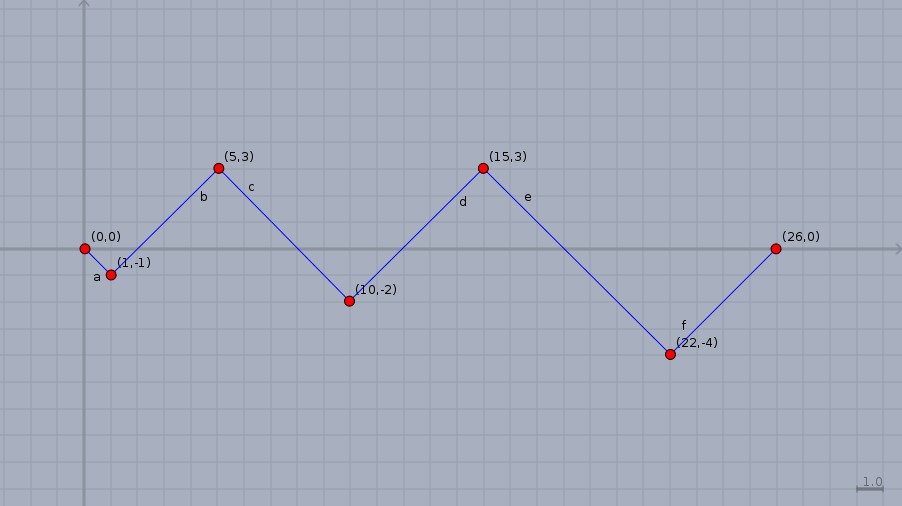This is definitely very far from being an answer, but still.
Let $f(t)=\sum_nF(n)t^n$ be the ogf for the numbers in question.
As in the comment by Timothy Chow, call a pair $\langle\boldsymbol a,\boldsymbol b\rangle$ indecomposable if $\boldsymbol a$ and $\boldsymbol b$ do not have common partial sums, that is, $a_1+...+a_i\ne b_1+...+b_j$ except for 0 and total. Let $\bar F(n)$ be the number of indecomposable unmatchable pairs with sum $=n$. The sequence $\bar F(1)/2,\bar F(2)/2,...$ starts with $0,1,3,10,27,80,216,621,1703,4824,13350,...$
Let $\bar f(t)$ be the generating function for $\bar F(n)$.
It is clear that each pair decomposes uniquely into indecomposables, hence $f=1+\bar f+\bar f^2+\bar f^3+...=\frac1{1-\bar f}$, so it suffices to compute $\bar f$.
Next, indecomposables can be similarly uniquely "glued" from "elementary" unmatchable pairs. A pair $\langle\boldsymbol a,\boldsymbol b\rangle$ is elementary if either $\boldsymbol a$ or $\boldsymbol b$ consists of a single number.
By a gluing I mean a situation like this:
$$\langle(a_1),(b_1,...,b_{j-1},x)\rangle;\langle(x,a_2,...,a_{i-1},y),(b_j)\rangle;\langle(a_i),(y,b_{j+1},...,b_{j'-1},z)\rangle;\langle(z,a_{i+1},...,a_{i'-1},t),(b_{j'})\rangle,...$$
Now it is not difficult to count elementary unmatchable pairs with given "ends". For fixed $x$ and $y$ let $F_{xy}(n)$ be the number of unmatchable pairs of the form $\langle(x+n+y),(x,...,y)\rangle$ and let $f_{xy}(t)=\sum F_{xy}(n)t^n$ be the corresponding generating function; then
$$
f_{xy}(t)=\frac{1-3t^2+2t^3-2^{d-1}t^{d+1}+2^dt^{d+3}}{(1-t)(1-4t^2)}-\begin{cases}0,&x\ne y\\\frac t{2(1-t)},&x=y\end{cases}
$$
where $d=|x-y|$.
Uniqueness of gluing then gives
$$
\bar f(t)=\sum_{k,x_0,x_1,x_2,...,x_k>0}f_{x_0x_1}(t)f_{x_1x_2}(t)\cdots f_{x_{k-1}x_k}(t)t^{x_0+x_1+x_2+...+x_k}.
$$
I had some functional equations when making a series of two variables out of this, but could not simplify it any further.
Followup
In response to comments by Martin Rubey - some modifications of the above. Since $f_{xy}(t)$ only depends on $|x-y|$, one may redefine them, denoting $f_{xy}(t)$ by $f_d(t)$, where $d=|x-y|$. Then grouping terms by powers of $f_d$ gives some additional information, but not much I'm afraid.
\begin{align*}
\frac12\bar f(t)=&\frac{t^2}{1-t^2}\left(f_0+2tf_1+2t^2f_2+2t^3f_3+...\right)\\
+&\frac{t^3}{1-t^3}\left(f_0^2+2t(1+t)f_0f_1+t(1+t+2t^2)f_1^2+2t^2(1+t^2)f_0f_2+...\right)\\
+&\frac{t^4}{1-t^4}\left(f_0^3+2t^2(1+t+t^2)f_0^2f_1+...\right)\\
+&...
\end{align*}
Followup-2
This could actually be added on the spot, don't know why I did not do it before. Still not a full answer, though.
The above considerations can also be used to obtain a recursion for $\bar F(n)$ as follows. let $\bar F_m(n)$ be the number of indecomposable unmatchable pairs $\langle(a_1,...,a_k),(b_1,...,b_l)\rangle$ with $a_k>b_l=m$ (thus $\bar F(n)=2\sum_{0<m<n}\bar F_m(n)$). Then
$$
\bar F_m(n)=\sum_{1\leqslant m'\leqslant n-m}E_{|m-m'|}(n-m-m')+\sum_{1\leqslant m'<n'\leqslant n-m}\bar F_{m'}(n')E_{|m-m'|}(n-m-n'),
$$
where $E_d(n)$ is the number, for any fixed $x$, of elementary unmatchable pairs of the form $\langle(x+n+x+d),(x,...,x+d)\rangle$ (this does not depend on $x$). Explicitly, $E_d(0)=1$ while for $n>0$,
$$
E_d(n)=
\begin{cases}
\frac13\left(\left(4+\frac{1+(-1)^n}2\right)2^{n-2}-2\right),&d=0,\\
\frac13\left(\left(4+\frac{1+(-1)^{d+n}}2\right)2^{n-2}-2^{d-1}\right),&0<d<n,\\
2^{n-1},&n\leqslant d.
\end{cases}
$$
This is quite computable, I just reached $\bar F(120)/2=58911664743785612350317153163016087887141938864410257$ in several minutes. On the whole, asymptotics seems to be something like
$$
\bar F(n)/2\sim (0.16532514842404...)\times(2.794251674002018...)^n.
$$
By the way, the first sum in the above recursion actually seems to simplify: for $m<n$,
$$
\sum_{1\leqslant m'\leqslant n-m}E_{|m-m'|}(n-m-m')=E_m(n-m),
$$
although I don't have a proof of it at the moment.
Followup-3
Let me also mention that the above recursion can be turned into a matrix equation as follows. Consider the infinite matrix $M=\left(t^if_{|i-j|}(t)\right)_{i,j\geqslant1}$ and the infinite vector $v=\left(t^d(f_d(t)-1)\right)_{d\geqslant1}$ (with $f_d(t)$ as in the first followup). Then
$$
\left(\sum_n\bar F_m(n)t^n\right)_{m\geqslant1}=(1-M)^{-1}v=(1+M+M^2+M^3+...)v.
$$

